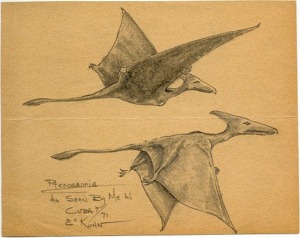Living Pterosaurs in the USA?
The following details are compiled from the June 23, 2018, update of “Declaration on Eyewitness Reports of Apparent Living Pterosaurs.” It seems easier to count the American states that do not have reported sightings of non-extinct “pterodactyls” than to count the ones that do. Here’s the accounting for the states that have such reports, including the District of Columbia (making a total of forty-one), beginning with the greatest number of sightings:
California = 39
Georgia = 15
Texas = 15
North Carolina = 13
Virginia = 11
Hawaii = 10
Ohio = 10
Utah = 10
Arkansas = 9
Pennsylvania = 9
Oklahoma = 8
South Carolina = 8
Washington = 8
Kansas = 7
Florida = 6
Illinois = 6
New York = 6
Missouri = 5
Wisconsin = 5
Louisiana = 4
Arizona = 3
Kentucky = 3
Massachusetts = 3
Mississippi = 3
New Mexico = 3
Oregon = 3
Michigan = 2
Minnesota = 2
Montana = 2
New Jersey = 2
Indiana = 2
West Virginia = 2
Alabama = 1
Connecticut = 1
District of Columbia = 1
Iowa = 1
Idaho = 1
Maine = 1
Nevada = 1
Rhode Island = 1
Tennessee = 1
.
The great majority of those 243 sightings of apparent “flying dinosaurs” were from Americans who contacted the cryptozoologist Jonathan Whitcomb, who published a listing of them on the Declaration page, along with a list of 47 other sightings from other areas of the world.
Whitcomb (now living in Murray, Utah) declares that those 243 reported encounters with living pterosaurs is just a tiny fraction of the total number of Americans who have gotten a clear view of that kind of flying creature:
“The number of legitimate sightings in the United States, over the past sixty years, could be a hundred times that many. The vast majority of Americans who see these flying creatures never report them to any cryptozoologist, and I’m just one of countless Americans who research sightings of cryptids.
“On the other hand, the person who reports an encounter to a newspaper will probably be ignored, for it’s just one person with a story that runs against generations of teachings about ancient extinctions. Very few news professionals, at least until recent years, have had any inkling of how many Americans have reported seeing living pterosaurs, and it’s just too strange to be published in most newspapers.”
.

Two large pterosaurs reported in Cuba in 1971
###
.
News release on living pterosaurs
A nonfiction-cryptozoology author has analyzed reports of non-extinct pterosaurs, commonly called “pterodactyls” or “flying dinosaurs,” and found how sightings relate to thirty-three states (and Washington D.C.) of the United States.
.
Sightings of pterosaurs in California
On March 18, 2013, I compared eight sighting reports of apparent pterosaurs in Southern California. The most recent sighting had been just fifteen days earlier, between Griffith Park and Glendale. Not one of those sightings was very far from a storm channel or stream bed.
.
Press release on modern pterosaurs
Reports of living “pterodactyls” in Georgia, during the past seven years, probably relate to sightings of some flying creatures in South Carolina and Florida, according to author Jonathan Whitcomb . . .
.
Non-extinct pterosaurs in the USA
“Reports of huge flying ‘pterodactyls’ in American skies have floated around the internet for years; but before about 2005, details were scarce. . . .”
.
Not all biology professors fight modern pterosaurs
A recent survey of biology professors in the USA reveals not all of them are completely convinced that all species of pterosaurs became extinct by 65 million years ago.
.
Many other eyewitnesses have seen apparent pterosaurs in many states of the USA, including in South Carolina, Florida, Georgia, Arkansas, and Texas. Yet these featherless flying creatures have been encountered in other areas of the United States, including California.
.
pterosaur
